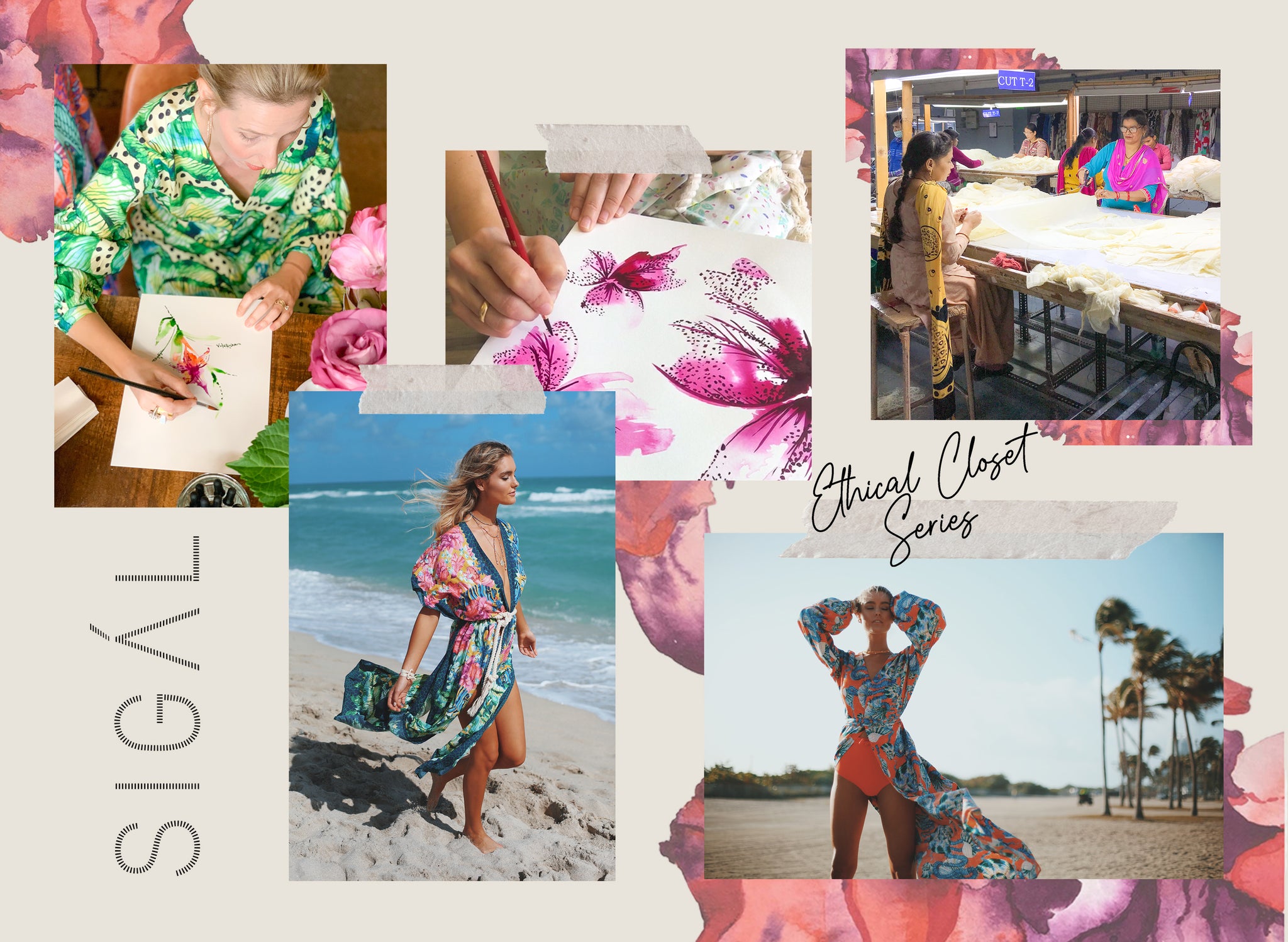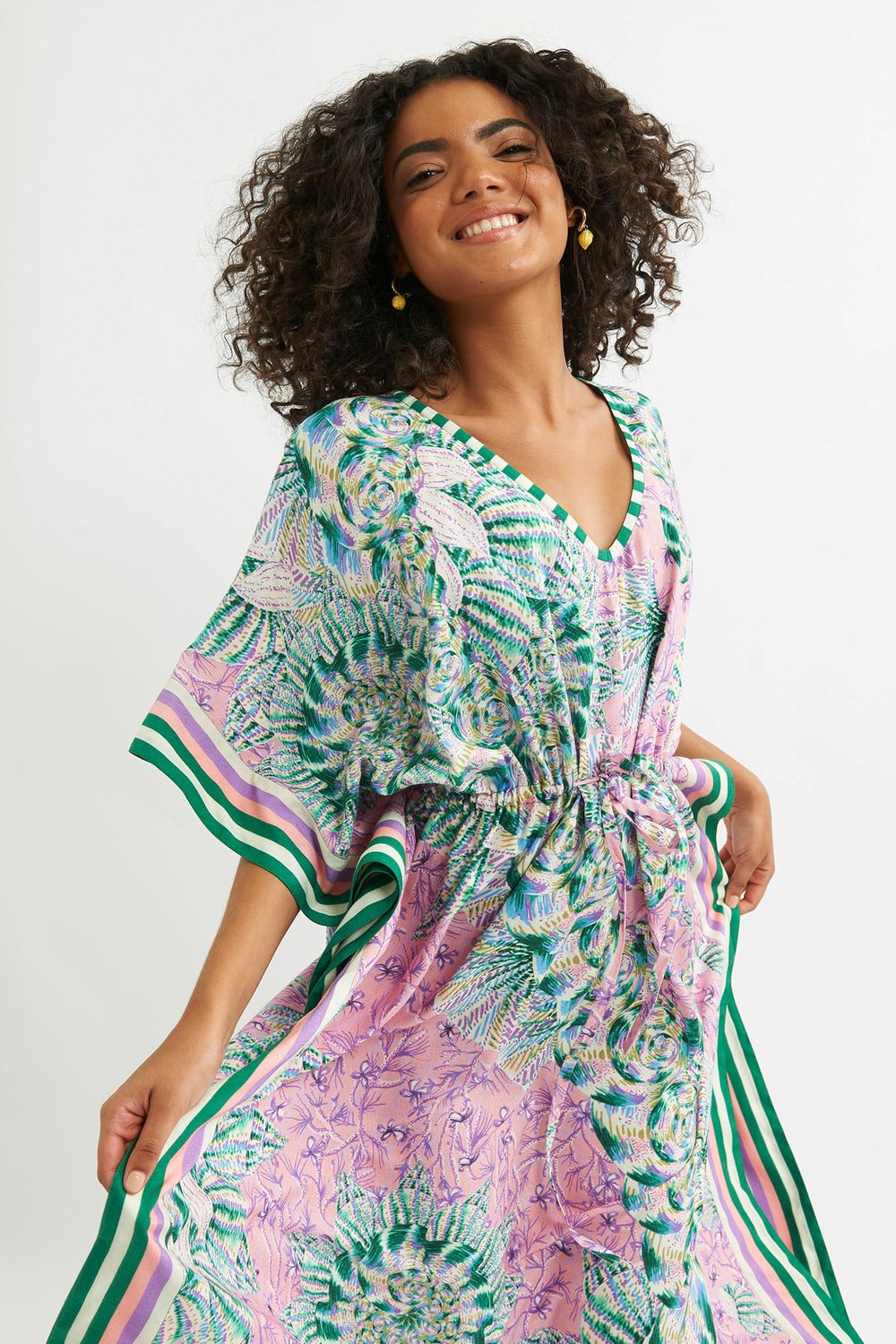
Don't miss: Instagram Live with Gabriella Smith and Sigal Cohen, May 7th 6pm EST @gabriellasmith!
In this week's Ethical Closet Series we speak to Sigal Cohen, founder and designer of SIGÁL, a brand that creates beautiful and ethical tropical resort wear.
Miami-based, Venezuelan designer, Sigal Cohen Wolkowiez is the sole creative force behind her namesake label SIGÁL. In 2008, Wolkowiez, a trained graphic designer, completed a Printed Textiles Program at London's Royal College of Art. Immediately after graduating from the program, she began handcrafting textiles with motifs including watercolor prints, ink illustrations, and collage techniques for various clients in the fashion industry.
In 2015, Wolkowiez decided to strike out on her own and launch SIGÁL to express her universe of color and textiles in an authentic way. Her visual language is informed by the cultural idiosyncrasies of her native country from the tropical landscape to indigenous fauna. The digitally printed textiles in each of Wolkowiez’s collections are inspired by a far-flung location enriched by her personal library of references.

UP: Tells us about your brand, why did you start your label?
SC: SIGÁL is an ethically crafted, statement resort wear brand that fuses my tropical upbringing in Venezuela with my background as a textile designer. Each collection is full of vibrant, festive colors and whimsical prints that come to life through effortless silhouettes—all made with natural fibers, such as lotus, linen, cotton, and silk.
I started SIGÁL with the goal of bringing boldly printed clothes to the world without harming it. I also wanted to create a collection that would represent the ease of coastal living. The perfect Miami casual uniform for every day and traveling.
UP: How do you get inspired to design your prints?
SC: I’ve always been inspired by the bright lights, lush nature, and Latin music of my hometown of Caracas. This, combined with the influence from my adopted hometown of Miami, its marine life, the art deco architecture, pastel color palette, and the confluence of culture from so many Latin countries here, results in my universe of Tropical Maximalism.
UP: What is the print design process like?
SC: The prints are meticulously created from hand-painted watercolor and ink-based art. These energetic works are created in a serendipitous fashion. Relying on emotions and improvisation, and sometimes observing palm trees and foliage from my window, I create impulsive strokes on paper with a brush soaked in water, in a process I call “blind painting.” I then drop ink which reveals the motifs drawn with water. Those marks eventually become more intentional, resulting in bold designs. I usually create other elements with bold marker traces, such as stripes, polka dots, animal skins, which I then combine with the watercolor designs to create the final prints. Most of them are placed directly on the garments in the collection.The garment then becomes a blank canvas on which each design element is intentionally positioned.

UP: How do you choose your materials?
SC: I have 5 pillars that the materials should comply with.
- Natural Fibers and sustainability: I only choose fabrics made with natural fibers such as cotton, linen, and silk. Most of our garments are made with a sustainable fabric called Lotus, which comes from the stem of the lotus flower. I work with a factory in India that is an expert in fabrics, and are also at the forefront of sustainability, together we find the best sustainable materials. I am also really excited because together we are developing a new Tencel fabric for my upcoming collections.
- Look: Since most of our fabrics are printed, it is important for the fabrics to have a beautiful look, to begin with, and that they properly absorb the inks.
- Drape: Most of our garments are flowy and effortless, they need to have an amazing drape, the fabric is the most important aspect to ensure that.
- Nice hand feel: Our goal is to make a feel-good collection; the fabrics need to be soft and delicious to the touch.
- Price: SIGÁL is an inclusive brand, and we can ensure that with accessible price points. Price plays a part in when choosing one fabric over another.
UP: What country do you manufacture in?
SC: Each piece is crafted at a family-owned, vertically integrated facility in India which was built with the environment in mind; over half of all water used is recycled, and the remaining is used to water trees that have been planted on-site. The fabric is woven there and then printed with Sigal's hand-painted designs, using only non-toxic inks. The scarves are the only exception, as they are crafted at a state-of-the-art printing facility in Shanghai, due to a higher quality of silk there than in India.

UP: Who makes your collections?
SC: My collections are made by women and men seamstresses at the factory we work with in Ludhiana, India. Women are in leadership roles, like quality control, management, and design, while men are pattern making and sewing the garments.
UP: How do you assure they are paid fairly?
SC: I have a very close relationship with the family that owns the factory in India, they take pride in treating and paying every single person that works there fairly. The also provided me with all the paperwork and certifications to back that. I was also able to see first hand how employees are respected, happy, well treated, and cared for. There was a real sense of pride in the workers, in the fabrics and clothes they are making.
Our factory also has this amazing foundation which was created to provide education for underprivileged girls. In India, only 48% of school-age going girls have access to Education. This results in poor literacy and grim economic outcomes. Girls are traditionally seen as an economic burden.
At Shingora, the factory which I work with, they created a foundation that provides the following for girls in Ludhiana:
- Overall improvement of economic productivity and growth.
- Reduction of child and maternal mortality.
- Improvement of child nutrition and health.
- Lower fertility rates.
- Reduction of social evils such as child marriage, dowry system, child labor, etc.
- Protection of girls from HIV/AIDS, abuse, and exploitation.
- Enhancement of women's domestic role, female empowerment, and family well-being: educated women will use their incomes to benefit their families.
- Food security and a decline in malnutrition.
This proves that this factory is really committed to improving the lives of their community.
UP: How often are you in contact with your artisans, factories, and seamstresses? Do you visit them?
SC: I am in daily contact with the factory that I work with, through email, chat and video conferences, and I just visited them in January, I am continuing to plan yearly trips.
UP: How many collections do you make a year?
SC: We make 1 limited edition collection per year, this last collection we split into 4 capsules or mini collections.

UP: Which one is your favorite piece in this collection?
SC: My favorite piece is the kaftan, it is so delicious and effortless, you can just throw it on, and it instantly lifts your mood. You can wear it loose, with flats and as a coverup, or tighter at the waist with heeled sandals for a summer night out.
UP: What advice do you have to create an ethical closet?
SC: Educate yourself about the brands that you are purchasing from, the materials and processes they use. Shop from small, limited edition collections. Get to know the values of the designers that lead those companies, see how transparent they are. Buy thrifted and vintage items, you can find unique things and it is also so fun to go treasure hunting.
Website: shopsigal.com
Instagram: @shopsigal

